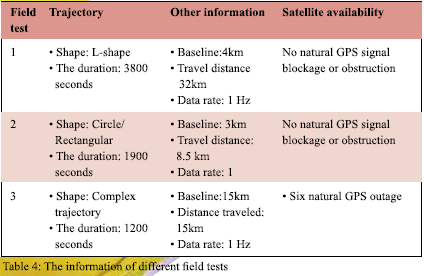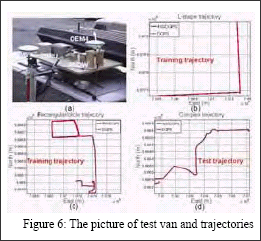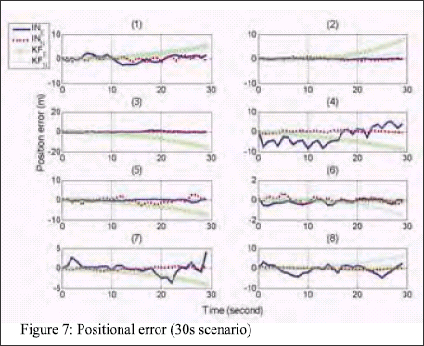| Navigation | |
The conceptual intelligent navigator
|
According to most of the NN related literatures, only the synaptic weights are interpreted as the learnt knowledge, however, Chiang [2004] suggested that the training samples that were applied during pervious learning processes should be stored and regarded as a part of the navigation knowledge to maintain the generalization capability of the proposed architecture after current or future learning process. As indicated in Figure (3), the synaptic weights are the core components of the navigation knowledge; the fi nal step towards building the conceptual intelligent navigator is to develop a strategy to accumulate the acquired navigation knowledge by updating the synaptic weights whenever the GPS signal is available. In the case of INS/GPS integration for navigation applications, it is required to track direction changes and mimic the motion dynamics utilizing the latest available INS and GPS data. In other words, the synaptic weights should be updated during the navigation process to adapt the network to the latest INS sensor errors and the latest dynamics condition whenever the GPS signal is available. To implement such criterion, Chiang et al., [2004] proposed a window based weights updating strategy to utilize the synaptic weights obtained during the conventional off-line training procedure (or probably from previous navigation missions) and stored in the NAVi. This criterion utilizes the latest available navigation information provided by the GPS signal window to adapt the stored synaptic weights so that they can be applied to mimic the latest motion dynamic and INS sensor error. Chiang et al., [2004] demonstrated the advantages of the proposed strategy in terms of the prediction accuracy during GPS signal blockages in real time mode. Since the ANNs training procedure takes time, updating the synaptic weights immediately at the latest available sample of a GPS signal before outage is diffi cult. However, the utilization of the proposed method can still provide reasonable prediction accuracy during GPS signal outages since it can utilize the latest acquired and learnt navigation knowledge to provide real time solutions. Therefore, the conceptual intelligent navigator has the ability to guarantee the knowledge evolution through the continuous learning process during the availability of GPS signal. Comparing to the traditional navigator that uses Kalman fi lter algorithm, the proposed conceptual intelligent navigator demands more storage space to accumulate navigation knowledge. However, as the accumulation of the navigation knowledge makes the conceptual intelligent navigator different from the traditional navigator, it is the price to pay [Chiang, 2004]. Results and discussionsTo evaluate the performance of the conceptual intelligent navigator, three fi eld tests were conducted on October 2003 by the Mobile Multi-sensor Systems (MMSS) research Group of the University of Calgary. The tests were conducted in land vehicle environments using different INS/GPS integrated systems consisting of a navigation grade IMU (Honeywell CIMU), MEMS IMU (Crossbow. The reference trajectories were generated by the CIMU/DGPS integrated system. The IMU and GPS measurements obtained through the fi rst and second fi eld tests using the above mentioned INS/DGPS integrated systems were applied to generate the stored navigation knowledge. After that, the third fi eld test was used as the test trajectory. To examine the difference between the conceptual intelligent navigator and the traditional navigator that consisted of a 15 state extended Kalman fi lter, Two short GPS outage scenarios (e.g., 30 seconds and 90 seconds) that have eight short GPS outages in each scenario (e.g. 6 natural and 2 simulated outage periods) were implemented. Then, the results predicted by both navigators were compared with the reference trajectory for further analysis. The goal of those scenarios is to evaluate the performance of conceptual intelligent navigator in more realistic environment. The stored navigation knowledge was acquired using the IMU and GPS measurements obtained through fi rst two fi eld tests. In addition, the window based weights updating strategy was applied to update the navigation knowledge during the availability of the GPS signal during the test trajectory. The window size was set to 60 seconds; however, the conceptual intelligent navigator was switched to prediction mode using the latest updated navigation knowledge acquired using pervious GPS window information whenever a GPS outage took place. Table 5, Figure (7) and Figure (8) compared the performance of conceptual intelligent navigator (IN) and traditional navigator (KF). As indicated Table 5, the conceptual intelligent navigator was superior to traditional navigator in both scenarios. The averaged improvement of conceptual intelligent navigator reached 47% and 78%, respectively. As indicated in both Figures (7) and (8), the positioning accuracy of aditional navigator decreases with longer GPS outage period. In other words, Table 5 illustrates that the improvement introduced by the conceptual intelligent navigator increases with longer GPS outages. The oscillations observed from Figures (7) and (8) were mainly affected by the motion dynamics of the vehicle. General speaking, both fi gure demonstrate that the time impact on the positioning accuracy of traditional navigator was more signifi cant than the impact of motion dynamic on the positioning accuracy of conceptual intelligent navigator. In The most important factor that affects the performance of the conceptual intelligent navigator is the accumulation and evolution of navigation knowledge. Theoretically, if enough navigation knowledge can be acquired in one or fewer fi eld tests, the conceptual intelligence might be able to operate in full prediction mode for every new navigation mission. However, the knowledge accumulation should be conducted whenever new navigation knowledge is acquired as the true motion dynamics of the vehicle operating in real life is far more complicated. With the presence of the conceptual intelligent navigator, the traditional navigator that uses a Kalman fi lter should be regarded as an optimal estimator, instead of a navigator, as it doesn’t have any ability to store and generalize the navigation knowledge that it has learned. In contrast, the conceptual intelligent navigator has the ability to generate, store and generalize the navigation knowledge it has learned. Comparing to traditional navigator, the conceptual intelligent navigator demands more storage space to store the navigation knowledge. As the accumulation of the navigation knowledge makes the conceptual intelligent navigator different from the traditional navigator, it is the price to pay. |

















 (No Ratings Yet)
(No Ratings Yet)





